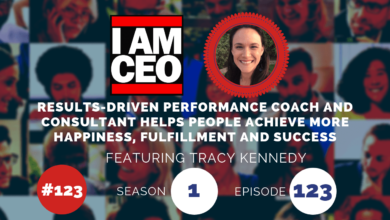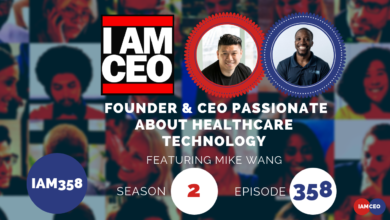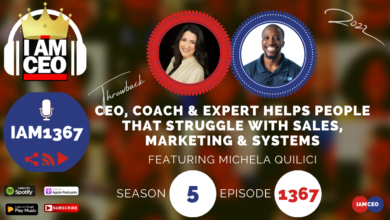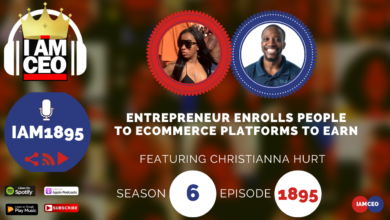IAM1714 – CEO Extracts Actionable Insights from Massive Datasets
Podcast Interview with Keshav Pingali
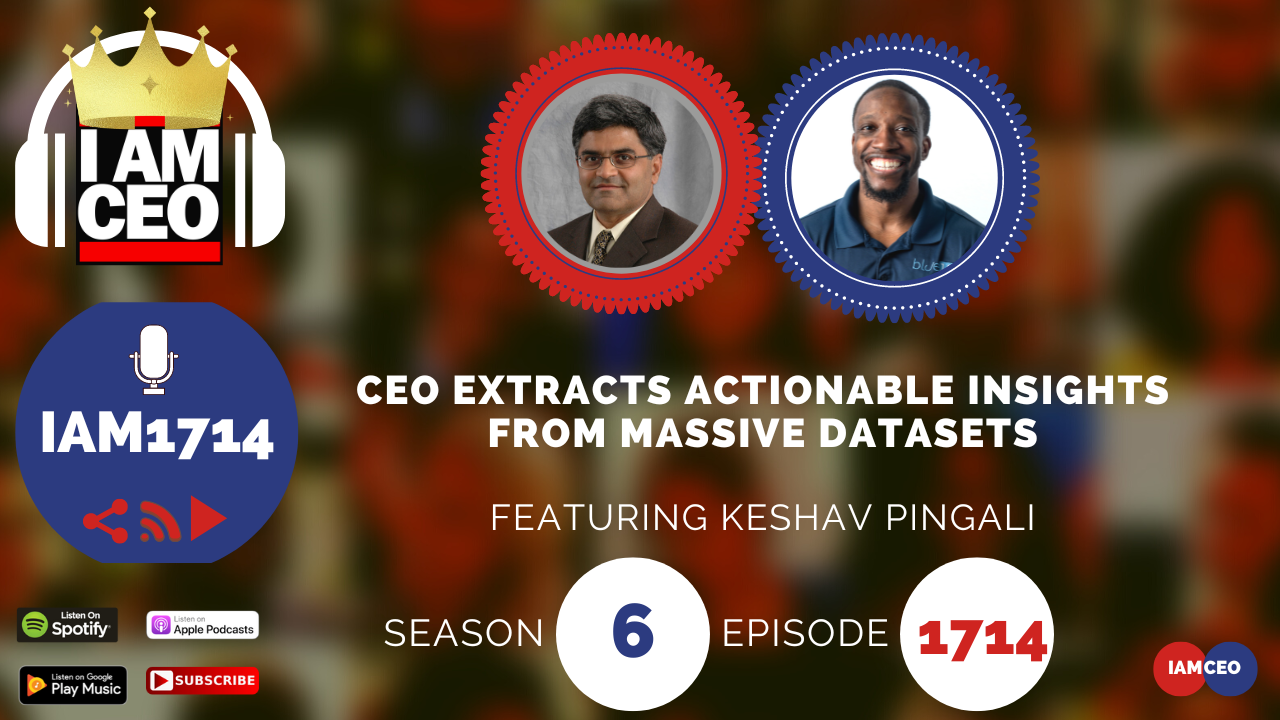 Why it was selected for “CBNation Architects”: Keshav has an impactful business and being able to understand how to make an impact from a data perspective. He understands that while data is important it's important to be able to extract and process that data. We forget how impactful and powerful it is to collect but also to process, extract and make decisions from the data.
Why it was selected for “CBNation Architects”: Keshav has an impactful business and being able to understand how to make an impact from a data perspective. He understands that while data is important it's important to be able to extract and process that data. We forget how impactful and powerful it is to collect but also to process, extract and make decisions from the data.
I AM CEO Handbook Volume 3 is HERE and it's FREE. Get your copy here: http://cbnation.co/iamceo3. Get the 100+ things that you can learn from 1600 business podcasts we recorded. Hear Gresh's story, learn the 16 business pillars from the podcast, find out about CBNation Architects and why you might be one and so much more. Did we mention it was FREE? Download it today!
Previous Episode: https://iamceo.co/2021/11/28/iam1203-ceo-extracts-actionable-insights-from-massive-datasets/
Transcription:
Keshav Pingali Teaser 00:00
So the ability to say no or the discipline, perhaps to say opportunities focused on others. I think I found that to be very important and it was one piece of advice that our investors, I was telling you about, gave me when we got started. They said that is the number one thing that you have to remember.
Intro [00:00:21]
Are you ready to hear business stories and learn effective ways to build relationships, generate sales, and level up your business from awesome CEOs, entrepreneurs, and founders. Without listening to a long, long, long interview? If so, You've come to the right place. Gresh values your time and is ready to share with you the valuable info you're in search of.
This is the I AM CEO podcast.
Gresham Harkless 00:48
Hello, hello, hello. This is Gresh from the I AM CEO podcast and I appreciate you listening to this episode. If you've been listening this year, you know that we hit 1600 episodes at the beginning of this year. We're doing something a little bit different where we are repurposing our favorite episodes around certain categories, topics, or as I like to call them, business pillars that we think are going to be extremely impactful for CEOs, entrepreneurs, and business owners, and what I like to call the CB nation architects who are looking to level up their organizations.
This month we are focused on technology. We're a technology company that does dot, dot, dot. Technology is no longer an afterthought or something that you might do and is actually a core part of your business. If you are a real estate investor, you're using it. If you're a financial firm, if you're a cleaning company, an author, or speaker, you are using technology. If you are any business, you are using technology, and if you're not, then you're probably going to be disrupted by an organization that is.
So this month we are going to look into purposing episodes that are around technology, whether that be firms or organizations that are actually using and investing in technology as a core part of their products and services, or potentially those individuals that are using and leveraging CEO hacks and CEO nuggets that center around technology and sharing ways that we can leverage it as well. Remember that you are a technology company that does dot, dot dot. Sit back and enjoy this special episode of the I am CEO podcast.
Hello, hello, hello. This is Gresh from the I AM CEO podcast. I have a very special guest on the show today, I have Keshav Pingali of Katana Graph. Keshav, it's great to have you on the show.
Keshav Pingali 02:18
It's good to see you, Gresham. Thank you so much for having me on your show.
Gresham Harkless 02:22
Yes, definitely the pleasure is all ours. You're doing so many phenomenal things, and what I wanted to do is just read a little bit more about Keshav so I can hear about all the awesome things that he's doing. Keshav is the CEO and co-founder of Katana Graph, a high performance scale out graph processing AI analytics company, which extracts actionable insights from massive unobstructed data sets.
Keshav holds the W.A. “Tex” Moncrief Chair of Computing at the University of Texas at Austin, and is a fellow of the ACM IEEE and AAAS. Keshav, great to have you on the show. Alphabet soup over here. Are you ready to speak to the I AM CEO community?
Keshav Pingali 02:59
Yes, I am. Nice introduction.
[restrict paid=”true”]
Gresham Harkless 03:01
Awesome, Yes. Thank you for doing all the hard work, so I get the opportunity to introduce you. So what I wanted to do to kick everything off was rewind the clock a little bit, hear a little bit more on how you got started, what I call your CEO story.
Keshav Pingali 03:12
Sure. So I grew up in India. I went to MIT for my PhD, and then I was a professor at Cornell for several years. And then I moved to UT I'm a chair professor, so my entire career I've been working in high-performance computing and traditionally high-performance computing, parallel computing. Cluster computing has been associated with computational science applications, so simulations of aircraft, wings, and, things like that.
But about 10 years ago, I and a group of my colleagues in high-performance computing realized that there was a big opportunity to bring techniques that we had developed for computational science applications and bring them to bear on graph analytics, graph AI obtaining insights very quickly from graph data. And so I've been doing that for the past 10 years. We did a bunch of DARPA projects. Because DARPA was interested in this technology, we built a system for them that did real-time intrusion detection in computer networks using graph technology, the graph platform that we built, and DARPA liked it sufficiently that they encouraged us to do a startup.
And about that time when this DARPA project ended about two years ago, I ran into a couple of very well-known entrepreneurs in Silicon Valley. So they asked me what we were doing. They saw the technology and they said you got to do a startup. And I said I'm a professor. I'm doing research. No, no, no. This is the time to do a startup in Graph plus AI. And so that's the short version of how we started Katana.
Gresham Harkless 04:53
Nice. I absolutely love that. And it sounds like it, it gives, and I guess for lack of a better term, people, those eyes and the ability to see, like you said, intrusions before they actually happen. So I feel like it allows you to kind of like quote and quote, see your blind spots it sounds like, as an organization. Is that correct?
Keshav Pingali 05:09
Yeah. So that's one application of graphics. What we are building is what we call a graph intelligence platform. So, there are you've heard terms like data tsunami or data flood. So the world is generating data at a much faster pace than we can actually analyze it. So there's a volume of data and then the other aspect to it is time to insight because very often there's a window of opportunity. If you can get your insights within that window of opportunity, then you actually benefit from it. But otherwise, if it's too late, then it doesn't matter, right?
So there's the volume of data and then there is the need to process all of this data very quickly. So that's where we come in because there is what is called structured data. So structured data is data that you can put into tables, and you have relational databases that have been around for 50 years, well-known technology, and lots of great companies like Oracle and so on in that area. But increasingly, the data that people are generating, devices are generating like IOT devices are what are called linked data. So it's unstructured data that can be represented like a graph and then processed using graph algorithms and for your listeners who may be unfamiliar with graphs, actually, everybody uses graphs, even if you don't know the term graph.
So if you take an airline group map, for example, what are cities and then lines that correspond to flights between cities. That's a graph. So we call the city's nodes, and then those lines, connecting nodes, we call them edges of the graph. Now, an airline roadmap typically might have a hundred or hundred nodes, and 200 cities. The graph data we deal with may have billions, hundreds of billions of nodes and trillions of edges. So there is a big need for processing that kind of enormous scale, making data, and doing it very fast.
Gresham Harkless 07:01
Yeah. That makes so much sense. I appreciate you breaking that down and especially understanding that time is of the essence in a lot of this situations where you need to understand and know what is going on with that data and be able to make decisions based on that.
Keshav Pingali 07:06
Yeah, that's right. So it's what we call cognitive intelligence. So the simplest level you take data that comes in and you represent it like a graph, and then you can just say what has happened. At the next level up you have what is called prescriptive analytics. So prescriptive analytics, you also say, why is something happening?
Then you wanna get to predictive analytics. That's even more difficult. So there you're trying to predict what may happen in the future based on everything that has happened in the past. And then where we want to be is what we call cognitive analytics. So there you basically are trying to reason or infer automatically using AI and machine learning techniques about why things are happening the way they are. So you build models as we call them, and then you use the models in order to make predictions about what may happen in the future. So that's cognitive analytics.
Gresham Harkless 08:04
Nice. I absolutely love that and then hearing the application of all these data that we have available and how you are able to make those predictive analysis and understanding what is potentially going to happen and make those decisions is absolutely huge. I love that you have been able to distill those things. I feel like I'll get an A now in my class professor so I appreciate you for breaking all of that down for me. I know that you already touched a little bit on how you serve your clients and how Katana Graph is working, is there anything you wanted to add and then what you feel is your secret sauce. It could be for you individually, the organization or a combination of both, it's what sets you apart and makes you unique?
Keshav Pingali 08:18
Yeah, I think what I'd like to say about Katana, what makes Katana unique is if you look at other graph computing companies in the space, they are what we call database first. So computing is secondary to what they do, which is searching the graph data for certain patterns that you're looking for. And so there are companies in this space.
What we are focusing on, however, is the analytics and the cognitive analytics and the graph intelligence aspect of it, which is not really search, but it focuses much more on very large-scale computing in order to extract properties of these graphs. So I'll give you a couple of examples from some of our users, the companies we work with. So we have gotten a lot of traction in the medical and pharma area, for example. So we are tied up with one of the biggest pharma companies in the world. So they have very big graphs that are called knowledge graphs. So these knowledge graphs basically incorporate everything that's known in the medical world and it's represented as a big graph over there.
So the vertices or the notes of this graph might represent people, papers, biological organisms, and treatments, and then the edges correspond to relationships between all of these entities. And what they want to do is to be able to mine these knowledge graphs in order to do what they call hypothesis generation. So hypothesis generation basically finds promising treatments for some particular disease and they also want to be able to rule out certain potential treatments cause it's a lot faster and cheaper to do it using a computer than going to a lab and finding out something that doesn't work. So that's an example that we actively working in, and there are lots of medical companies that we could work with.
Another area that's really exciting is what's called precision medicine. So if you go to a doctor right now and he diagnoses you with some disease, chances are he'll give you some treatment that's very similar to what he gives everybody else who has that disease. But obviously, if we take into account your medical history and your genetic profiles and everything that's known about your parents and grandparents and all the information that makes you, makes you special, then we might be able to give you a more targeted treatment than the generic treatment. So again, there is an enormous amount of data that needs to be processed fast. And so we are doing another contract with a couple of precision medicine.
And then there are other applications in security. We also already talked about intrusion detection in computer networks. So bad guys are trying to break into a network and misuse your resources. You wanna catch them as quickly as possible. So graph technologies are used very heavily over there. And again, the graphs are very big. And in that application you can see why time is very important cause you wanna catch the bad guys before they have a chance to do any damage, blasting damage to your information security.
So there are lots and lots of applications of graph technologies and in particular, this graph intelligence platform that we're building. Again, just to tie this back, what makes us unique is the fact that we are what we call a graph intelligence platform first, as opposed to a graph database first. So we focus on the compute rather than on the search capability, which is where traditionally graph companies are focused on.
Gresham Harkless 11:41
Would you consider that to be what I like to call your CEO hack? The thing that makes you more effective and efficient is it the ability to say no to sometimes all the opportunities that you might be presented with, but decide to laser focus on those three verticals that you have.
Keshav Pingali 11:53
Yeah, I think that's one of them. So the ability to say no or the discipline perhaps to say opportunities are focused on others. I think I found that to be very important and it was one piece of advice that our investors, I was telling you about, gave me when we got started. That is the number one thing that you have to remember.
Then the other thing that helps me in terms of a business hack or a business resource is I grew up in India, as I was telling you, and one of our ancient books is called the Bhagavad Gita. So the Gita is, you can think of it as like one of the books of the Bible, right? In context. And what the Bhagavad Gita tells us is that the most noble thing any human being can do is to do his duty. So doing your duty is the most important thing, and if you've done your duty well, then you've fulfilled your obligations as a human being.
Gresham Harkless 12:52
No, I absolutely appreciate that. And so now I wanted to ask you my absolute favorite question, which is the definition of what it means to be a CEO. We're hoping to have different quote and quote, CEOs on this show. So Keshav what does being a CEO mean to you?
Keshav Pingali 13:03
I think I'd go back to the answer I gave you earlier about duty and responsibility, right? There are three constituents for me as a CEO, three groups that I have a duty to, a responsibility to. First and foremost to our customers because they're trusting us to solve problems for them. Equally important is my responsibility to my team. We try to have a nurturing culture over here. One of our mottos at Katana is this Japanese word called kaizen, right? Which means continuous improvement. So you shouldn't be afraid of making mistakes. But you shouldn't make the same mistake twice. Because otherwise, if you're punitive about people who make mistakes, then nobody will take risks. And that is the biggest risk of all. And so we nurture our team members, and we help them to grow in their careers.
Then the third constituency, of course, is our investors because they have put a lot of trust and frankly money in Katana. And so, we need to make sure that we are responsive to their imperatives. So I think for me, being a CEO just goes back to these two words, duty and responsibility. Then the final thing that I'd like to add as an immigrant to the US is that I have benefited tremendously from the openness of American society. The ability of Americans to judge people based on their talents and what they bring to this country as opposed to where they were born, right? And of course, we need to make the country a better place and we need to eliminate problems that exist and so on.
I am very grateful as an immigrant for the opportunities that America has given me and I want the rest of my career to put back into America and make this a better place for both everybody who's born here as well as people who move here from other places.
Gresham Harkless 14:55
I appreciate you so much for doing that and that perspective and of course for your time today. So, one thing I wanted to do was pass you the mic again just to see if there's anything additional that you want to let our readers and listeners know, and of course, how best they can get ahold of you and find about all the awesome things you and your team are working on.
Keshav Pingali 15:09
You know, I just wanna go back to our main theme, which is we are building this graph intelligence platform, scale-out very fast processing of enormous amounts of data to get it actionable insights. And so I think that is the wave of the future and we plan to be at the crest of that wave.
You can get in touch with me, you can go to our website, which is katanagraph.com and you'll find a lot more information about Katana, what we do, team members, customers, and all of that. We also have a presence on Twitter, LinkedIn, and Youtube, and all those links are there on our website. And of course, you can send me an email, kbengali@katanagraph.com will always reach me.
Gresham Harkless 15:51
Awesome, awesome, awesome. And to make it even easier, we'll have the links and information in the show notes too so that everybody can follow up with you. Keshav I truly appreciate that spirit that you have and that you brought to us today, and to remind us of how important it's to constantly get better, whether we're talking about the product that you're creating, for the things that we could do related to our duty, our responsibility in understanding the people that we have an impact on in so many different ways.
So thank you so much for reminding us of that. Of course doing that so well, and I hope you have a phenomenal rest of the day.
Outro 16:17
Thank you for listening to the I am CEO podcast, powered by CB Nation and Blue 16 media. Tune in next time and visit us at iamceo.co. I am CEO is not just a phrase. It's a community. Get your driven CEO gear at ceogear.co. This has been the I AM CEO podcast with Gresham Harkless, Jr.
Thank you for listening.
[/restrict]


